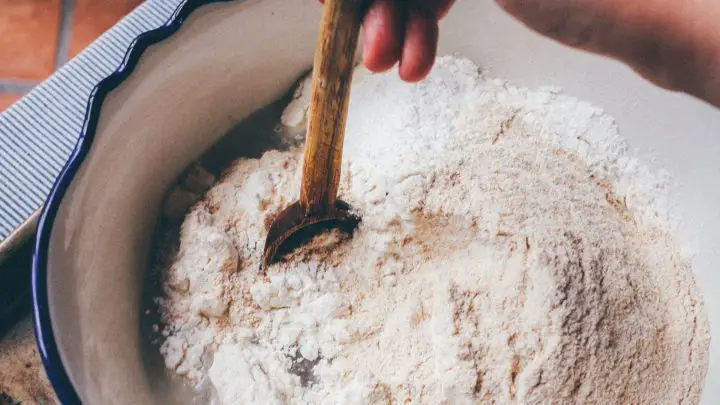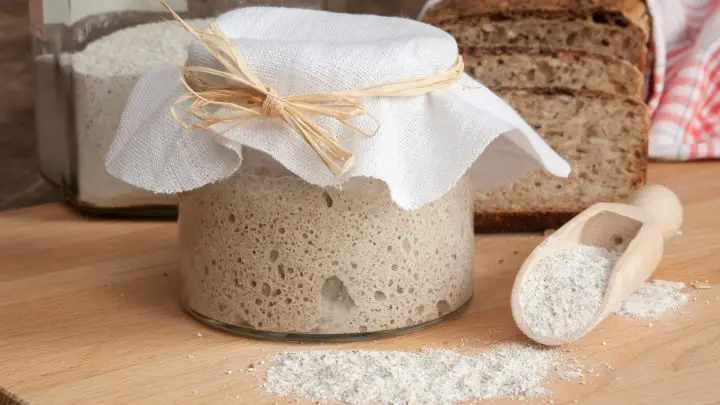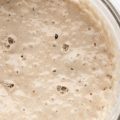Sourdough bread requires an active and strong sourdough starter, which can sometimes become weak and produce disappointing results. To ensure successful bread baking, several steps can be taken, such as adjusting the feeding schedule, using higher protein flour, adjusting hydration, maintaining consistent temperature, and being patient. This article provides a step-by-step guide on how to strengthen a sourdough starter for improved bread baking results.

Table of Contents
- What is a Strong Sourdough Starter?
- How To Strengthen A Weak Sourdough Starter Step-By-Step
- How Do I Know If My Sourdough Starter Is Strong Enough?
- 7 Tips To Increase The Strength of a Sourdough Starter
- Strong Sourdough Starter
- FAQ’s
What is a Strong Sourdough Starter?
A strong sourdough starter refers to a robust and healthy culture of wild yeast and beneficial bacteria used in sourdough bread baking. It displays vigorous fermentation activity, rising bread dough consistently and providing excellent leavening power.
A strong starter exhibits a balanced aroma, and a good rise in baking, and imparts desirable flavor characteristics to the finished sourdough bread. It is often maintained through regular feeding and proper care to keep it active and resilient.
How To Strengthen A Weak Sourdough Starter Step-By-Step
If you have determined that your sourdough starter is weak, don’t worry, there are steps you can take to strengthen it. Here are the steps to follow:
- Feed your starter more frequently: If you normally feed your starter once a day, try feeding it twice a day for a few days. This will give the yeast and bacteria in the starter more food to ferment, which can help strengthen the starter.
- Use a higher protein flour: Switch to a flour with a higher protein content, such as bread flour, to give your starter more gluten to work with. Gluten provides structure to the bread dough and helps it rise, so a higher protein content can help strengthen the starter.
- Adjust the hydration: If your starter is too wet or too dry, it can affect its strength. If it’s too wet, try reducing the amount of water you add when you feed it. If it’s too dry, add a little more water to the mix.
- Keep the temperature consistent: Yeast and bacteria thrive in a warm environment, so keeping your starter at a consistent temperature can help it grow stronger. Ideally, keep your starter at around 75-80°F (24-27°C).
- Be patient: It may take a few days or even a week or two for your sourdough starter to regain its strength. Keep feeding it regularly and monitoring its progress.
- Consider starting a new starter: If your sourdough starter is still weak after trying the tips below, you may need to start over with a new starter. This can be done by mixing equal parts flour and water and letting it sit at room temperature for a few days until it becomes active. You can then use this new starter to make bread or incorporate it into your existing starter.
Remember, sourdough starters are living organisms, and they can be affected by many factors. With patience and persistence, you can revive a weak sourdough starter and continue to bake delicious, homemade bread.
How To Tell When Your Sourdough Starter Is Weak?
A weak sourdough starter may not be able to produce the necessary amount of leavening agents to make bread rise properly, resulting in a dense and heavy loaf.
Here are some signs that your sourdough starter may be weak:
- Lack of activity: A healthy sourdough starter should show signs of fermentation within a few hours of feeding, such as bubbles and a noticeable increase in volume. If your starter is not showing any signs of activity, it may be weak.
- Slow fermentation: If your sourdough starter is taking much longer to double in size after feeding than it used to, it may be a sign of a weakened starter.
- Discoloration: A healthy sourdough starter should be a light beige or tan color. If your starter has turned dark or has a gray or pinkish hue, it may indicate the growth of harmful bacteria, which can weaken the starter.
- Unpleasant odor: While sourdough starter will naturally have a slightly sour smell, a foul or rancid odor may indicate the presence of harmful bacteria.
- Separation: A healthy sourdough starter should be relatively uniform in texture. If you notice that the starter has separated into layers, with a watery layer on top, it may be a sign that the starter is weak and not fermenting properly.
If you notice any of these signs, you may need to take steps to revive your sourdough starter. This may involve increasing the frequency of feedings, changing the type of flour you use, or even starting a new starter from scratch.

How Do I Know If My Sourdough Starter Is Strong Enough?
Consistent Rise And Activity
One way to assess the strength of your sourdough starter is by observing its rise and activity.
A strong starter will consistently double in size within a predictable time frame after each feeding. It should exhibit robust fermentation activity, with plenty of bubbles throughout the starter. These signs indicate that the yeast and bacteria in the starter are active and multiplying effectively, demonstrating its strength.
Aromatic And Tangy Smell
The aroma of your sourdough starter can provide valuable insights into its strength.
A mature and strong starter typically emits a pleasant, slightly tangy smell. This aroma is a result of the fermentation process and indicates that the starter has developed a healthy balance of yeast and bacteria.
If the smell is overly acidic or unpleasant, it may indicate that the starter needs more regular feedings or attention to reach its full strength.
Texture And Consistency
The texture and consistency of your sourdough starter can also provide clues about its strength.
A strong starter will have a creamy and elastic texture. When you stir the starter, it should hold its shape and exhibit a certain level of viscosity. This indicates that the starter has developed a good gluten structure and is capable of trapping gas produced during fermentation, contributing to its strength.
Reliable Leavening Powder
When using your sourdough starter in bread dough, its leavening power is a crucial indicator of its strength.
A strong starter will consistently provide good rise and leavening, resulting in well-fermented and fluffy loaves of sourdough bread. If your starter consistently produces well-risen bread with an open crumb structure, it suggests that the starter is robust and has enough strength to leaven the dough effectively.
Consistency Over Time
To truly determine if your sourdough starter is strong enough, it’s essential to observe its consistency over time.
A strong starter should display the aforementioned characteristics consistently, not just occasionally. It should exhibit reliable rise, activity, aroma, texture, and leavening power consistently over several feedings and baking cycles. This indicates that the starter has reached a mature and stable state, demonstrating its strength and reliability.

7 Tips To Increase The Strength of a Sourdough Starter
To increase the strength of your sourdough starter, consider the following tips:
Regular Feedings And Discard
First and foremost, regular feedings and discard are essential. Maintaining a consistent feeding schedule, ideally every 12 hours or once a day, ensures that the yeast and bacteria remain active and continue to grow.
Before each feeding, discard a portion of your existing starter, usually about half, to prevent it from becoming overly acidic and to create space for fresh nutrients.
Balanced Feeding Ratio
A balanced feeding ratio is crucial for a strong starter.
Use a ratio of 1:1 or 1:2 (starter: flour) by weight. This provides sufficient food for the microorganisms to thrive. Additionally, experimenting with different flour types, such as whole wheat or rye, can add extra nutrients and contribute to flavor complexity.
Optimal Hydration Level
The hydration level of your starter plays a significant role. Adjust the hydration based on your preferences and desired outcome.
A wetter starter with higher hydration promotes more fermentation activity, resulting in a stronger starter. On the other hand, a stiffer starter with lower hydration may lead to slower fermentation.
Finding the right balance that works for you is key.
Temperature Control
Maintaining an optimal temperature range during fermentation is vital. Aim for temperatures between 75-85°F (24-29°C) to encourage yeast growth and activity.
You can achieve this by using a proofing box, finding a warm spot in your kitchen, or creating a temperature-controlled environment for your starter.
Feeding At Peak Activity
Feeding your starter when it is at its peak activity is recommended. This typically occurs when the starter has doubled in size and exhibits a bubbly texture. Feeding at this stage ensures that you are providing fresh food to the starter when it is at its strongest.
Patience And Consistency
Remember that developing a strong sourdough starter requires patience and consistency. It takes time for the starter to mature and develop its full potential. Be patient and maintain a regular feeding routine, allowing the starter to gradually strengthen over several days or even a couple of weeks.
Hygiene And Contamination Avoidance
Lastly, practicing good hygiene is essential.
Use clean utensils and containers when handling your starter to avoid introducing unwanted bacteria or contaminants. Keep your starter away from strong odors, as it can absorb them and potentially affect its flavor and strength.
Strong Sourdough Starter
To strengthen a weak sourdough starter, feed it more frequently, use higher protein flour, adjust hydration, maintain consistent temperature, and be patient.
Reviving a sourdough starter takes time and care, but with persistence, you can enjoy delicious homemade bread with a healthy, robust starter.
FAQ’s
How To Tell When Your Sourdough Starter Is Weak?
Signs of a weak sourdough starter include no bubbles on the surface of your starter, no expansion after each feed, a thin consistency, a bad smell, or a slow rise time.
What To Do If Your Sourdough Starter Is Very Weak or Completely Flat?
If you notice your starter is very weak or completely flat then you may need to feed your starter more frequently, use warm water and flour, change the type of flour, mix in some commercial yeast, and above all practice patience and persistence.
Why is My Sourdough Starter Not Very Active?
Lack of feeding, inconsistent feeding, cold temperatures, contamination, or low-fiber flour can all be reasons why your starter may not be very active.




![How To Freeze Sourdough Starter [Top Tips For Success] 7 How to freeze sourdough starter [top tips for success]](https://www.mydailysourdoughbread.com/wp-content/uploads/2023/06/storing-starter-in-freezer-120x120.jpg)
![How To Keep Sourdough Starter Warm [Best Tips And Why You Need To] 8 How to keep sourdough starter warm [best tips]](https://www.mydailysourdoughbread.com/wp-content/uploads/2023/07/a-bubbly-starter-on-a-cooling-rack-120x120.jpg)